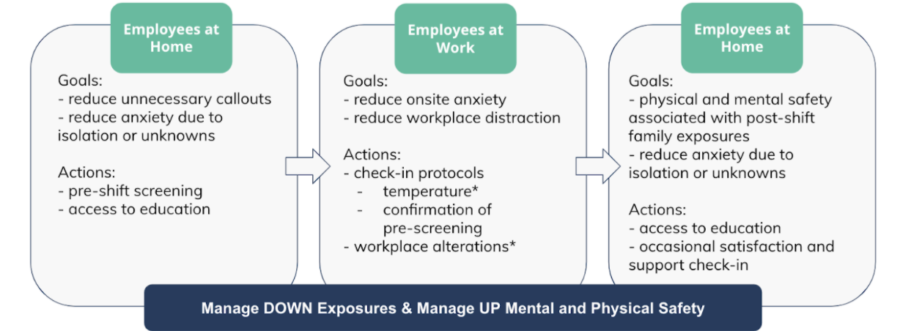
Across the country and across industries, companies have closed their workplaces or operated at a reduced capacity to help manage the spread of COVID-19. Now, as more than half of the states begin to lift stay-at-home orders and allow businesses to reopen, the process of creating safe work environments is underway.
New rules around employee testing
Our customers and other business leaders say testing and screening helps to reduce COVID-19 transmissions and improve morale by creating a safe workplace. Employers are generally not allowed to inquire about workers’ medical conditions. But the Equal Employment Opportunity Commission issued new rules in April permitting employers to test for COVID-19 as a condition for entering the workplace.
Testing alone is not enough. A successful reopening strategy requires regular health screenings, compliance reporting, automated care pathways, and employee engagement and education about new processes and procedures. –Travis Woyner, Dina Vice President of Operations
A successful reopening plan is designed to reduce COVID-19 exposure and increase employee health, safety and morale. Here are five steps to get you started.
1. Organize Your Resources
With any large undertaking, it is important to organize your resources and obtain operational buy-in. As you think about your program and protocols, start by understanding current operations and resources that can impact a clear reopening strategy. This should include gathering information like: How many employees do you need to account for? Where and how do your employees interact? What is the associated management structure for your employees? What tools do you already have in place to support the health and wellness of your employees?
2. Set Goals
Once current resources are identified, set clearly defined operational goals. These should include how you plan to leverage technology for outreach, alter the physical workplace if needed, connect employees to occupational health support, and share any updated human resources policies that reflect current working conditions.
3. Use Screening Data to Establish Baselines
A proper baseline helps create an informed reopening plan. There are two ways to establish a baseline. The first way is testing for COVID-19. Depending on the availability of tests and budget, a broad testing program is the surest way to understand the health of your workforce.
The second way is with a robust employee screening program. By gathering information daily from employees regarding potential COVID-19 symptoms or exposure, you can create a rolling database of staff health and availability. Once established, you can use data to direct employees to self-care, telehealth consults, or live follow ups from human resources or occupational health managers, as needed.
4. Pre-Shift Health Screenings
IR temperature checks and scanning capabilities, centralized points of entry to allow for forehead scanning, and physical barriers or floor designations to drive social distancing are important measures.
However, when used in isolation, they only address one aspect of an employee’s day: when they have already arrived at the workplace. Every day, employees are traveling from home to the workplace and back. They may be stopping in grocery stores or other businesses. The full cycle of work must be considered in your plan.
We recommend a pre-shift screening mechanism to ensure employees are healthy prior to arriving at the workplace, and that the work environment is safe.
5. Educate Staff
Everyone benefits from knowing that their employer is taking steps to keep them safe, and has a plan ready to share. In our customer implementations, we’ve seen that education keeps engagement rates high and improves morale. A few examples:
- Communicate with employees so they know what to expect at every step.
- Tell employees why screening is necessary and how data will be used.
- Educate staff about the ways you will “manage up” mental and physical safety.
- Provide resources and support. This might include instructions for safely checking into the workplace, reminders to wash hands, or occasional satisfaction check-ins.
- Solicit suggestions and feedback.
Dina’s screening solutions
Our employee wellness and health screening solutions are live in 17 states and we’re managing nearly 10,000 daily health screenings. Learn how we can help guide your COVID-19 reopening strategy with pre-shift employee screenings, automated care pathways, and reporting for managed risk HR/compliance. Interested in learning more about Dina? Sign up here for regular news and updates.





